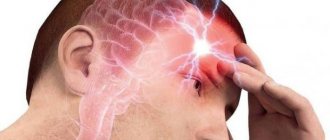The world is just beginning to recover from the coronavirus epidemic, which has literally divided the lives of millions of people into “before and after.”
As a practicing cardiologist at the “Healer” medical clinic in Khasavyurt, I have to deal every day with patients who come for appointments with manifestations of cardioneurosis.
I can assure you that recently this is primarily due to the consequences of the epidemic. The fact is that cardiac neurosis occurs against the background of mental factors or, as experts say, it is a functional cardiac disorder that has a psychogenic etiology.
Types of pathology and its symptoms
In medical sources you can find various names for cardioneurosis, such as: cardiac neurosis or cardiac neurosis, neurocirculatory, vegetative-vascular dystonia, functional cardiopathy or psychovegetative syndrome. These are all different names for the same disease.
The main forms of manifestation of cardioneurosis are:
1. Cardiological, which is expressed by attacks of pain in the heart.
- Panic. This form is characterized by manifestations of a panic attack.
What examinations are necessary to make a reliable diagnosis of cardioneurosis?
In order to exclude organic heart pathology and other serious diseases hidden behind a variety of symptoms, the patient must be observed for at least 2 months. At the same time, the connection of attacks with stressful situations and circumstances that have a stimulating effect on the patient’s psyche is of decisive importance in favor of cardioneurosis. Only after excluding structural changes and making sure of the functional nature of the symptoms can a diagnosis of cardioneurosis be made.
Specifically, the examination plan should include the following activities: • Detailed and thorough history taking. • Physical (physical) examination of the patient with determination of signs of asthenia, excessive sweating, skin color, etc. • Electrocardiographic examination (one-time and in the form of daily monitoring), ultrasound of the heart, ultrasound of the cervical vessels, etc. • Breathing tests to study the function of external respiration . • Clinical and biochemical blood test with determination of AST, LDH, lipid profile, C-reactive protein, creatine kinase, thyroid hormones and potassium. To exclude the diagnosis of acute myocardial infarction, cardiac troponins and myoglobin are determined. • FGDS for severe dyspeptic syndromes. • Electroencephalogram for studying the brain and identifying its pathologies (epilepsy, neoplasms, inflammatory processes and vascular disorders).
Consultations with specialized specialists are required - cardiologist, neurologist, endocrinologist, psychotherapist, gastroenterologist, etc.
Signs of the disease
Among the most common symptoms of the disease are:
- pain in the chest area. The pain can be pressing and aching. Often, clinic patients complain of piercing, sharp pain in the heart area, to the point where it feels like the heart has stopped, followed by an increase in heart rate;
- physical or mental stress leads to heart rhythm disturbances or increased heart rate;
- a feeling of chills or, conversely, a rush of heat, sweating, possible shortness of breath, a feeling of lack of air;
- high blood pressure, often accompanied by headache, weakness, dizziness;
- panic, fear of death, anxiety, sleep disturbances.
Candidate of Medical Sciences, psychiatrist V. E. Medvedev. In 1871, a disorder was described characterized by complaints of palpitations, pain in the heart area, rapid pulse, a feeling of shortness of breath, headaches, irritability, and sleep disturbances. The author who identified this syndrome, whose name is also used in modern literature (Da Costa syndrome, cardiac neurosis ), emphasizes that the clinical picture is dominated by unpleasant sensations in the chest, which are comparable to typical ischemic pain that develops in the form of attacks or attacks. To designate these conditions in the medical literature, the term “ neurocirculatory (vegetative-vascular) dystonia ” (NCD) has been used for a long time; in foreign sources – “asthenia”. Currently, vegetative-vascular dystonia is a common designation in medical practice for vegetative disorders of various origins and manifestations, but fundamentally functional, caused by a violation of the neurohumoral regulation of vegetative functions.
At the same time, ICD-10 presents a different position: in this classification, built on a syndromic basis, “Somatoform disorders” (F45) occupy the position of an independent taxon, within which the category “Somatoform autonomic dysfunction” (F45.3), including diagnostic rubric “Somatoform autonomic dysfunction of the heart and cardiovascular system” (F45.30). It is under this heading that such forms as cardiac neurosis, Da Costa syndrome, and neurocirculatory asthenia are included. However, the question of the identity of the diagnoses of neurocirculatory dystonia and cardioneurosis remains controversial to this day.
According to the observations of domestic and foreign authors, the number of patients with functional disorders of the cardiovascular system - cardioneurosis ( neurocirculatory dystonia , d'Acosta syndrome, tension syndrome, "soldier's", "broken" heart) reaches 15-30% of patients in specialized cardiology hospitals. According to the results of an epidemiological study (2181 patients, of which 1718 were multidisciplinary hospitals and 463 territorial clinics) carried out at the Scientific Center for Healthcare of the Russian Academy of Medical Sciences, cardioneurosis occurs in 4.7% of patients in the general medical network. Among the outpatient population, this disorder is detected much more often - 15.6% versus 2% in a multidisciplinary hospital.
Cardioneurosis (neurocirculatory asthenia, dystonia, d'Acosta syndrome, tension syndrome, "soldier's", "broken" heart) is an independent psychosomatic disorder of a circle of organ neuroses, in which the formation of autonomic dysfunctions, somatoform disorders and algia occurs according to functional mechanisms.
Manifestation and repeated exacerbations of symptoms in approximately 30% of patients are provoked psychogenically, alcohol abuse, trauma or surgical interventions, repeated pregnancies and childbirth. In other patients, the disease occurs without visible provocation and is often associated with periods of hormonal changes in the body (puberty, first pregnancy) and/or the presence of morphological abnormalities of the heart (mitral valve prolapse, accessory chord).
Patients with cardioneurosis are characterized by the presence of persistent or episodic symptom complexes for at least 2 consecutive years: various somatoform disorders simulating symptoms of diseases of the cardiovascular system (including bodily fantasies, conversions, cardialgia), anxiety-phobic disorders (fear of stroke, heart attack, death from cardiac arrest, etc.), accompanied by sensations of irregular heartbeat with a tendency to tachycardia, revealed during physical examination by lability of blood pressure (hyper/hypotension), acute vegetative symptom complexes simulating urgent cardiovascular pathology (orthostasis, fainting, dizziness), as well as depressive symptom complexes (low mood, apathy, pessimistic assessment of the future, etc.). Other signs of cardioneurosis are symptoms of autonomic dysfunction detected during physical examination: local sweating, marbling or coldness of the extremities, persistent white dermographism; lability and nonspecific changes in the final part of the ventricular complex; temporary reversion of the T wave during exercise testing.
Cardioneurosis with dominance of bodily sensations (sensopathy) is characterized by a predominance of idiopathic cardialgia, tachycardia and bradycardia, orthostatic phenomena, syncope and autonomic disorders (subsyndromal panic attacks). The clinical picture of cardioneurosis with a predominance of anxiety-phobic disorders is characterized by polymorphism. Against the background of anxiety-phobic disorders with fears of cardiovascular catastrophe and death, panic attacks, 5-10% of patients exhibit agoraphobia, as well as bodily fantasies, acute autonomic disorders and symptom complexes of organoneurotic disorders of other organ systems (irritable bowel or bladder syndrome, hyperventilation) . A feature of the clinical picture of cardioneurosis with a predominance of affective disorders is the persistence of cardioneurotic symptoms against the background of depressive phases within the dynamics of affective personality disorders. The picture of depression is dominated by astheno-apathetic or hypochondriacal manifestations.
The criteria for cardioneurosis, taking into account the complexity of psychosomatic relationships, provide for a comprehensive assessment of the condition, with the participation of a psychiatrist and cardiologist. At the same time, the diagnosis of cardioneurosis is a “diagnosis of exclusion”; To stage it, it is necessary to completely exclude the presence of cardiovascular pathology (coronary heart disease, hypertension, heart failure, atrial fibrillation, etc.), as well as any other somatic disease, the features of which could explain the existing symptoms. The diagnosis of NCD (cardioneurosis) is confirmed during repeated examinations, including the assessment of physical, instrumental and laboratory parameters (including routine clinical and biochemical blood tests, lipid spectrum, ECG, ECHO-CG, daily Holter ECG and blood pressure monitoring, treadmill, peak expiratory flow (PEF), capnography study, blood gas composition, voluntary hyperventilation test, spirometry). To exclude organic pathology of the brain, MRI and EEG studies were performed. In addition, during a psychopathological examination, it is necessary to exclude the manifestation of endogenous psychosis (schizophrenia, schizoaffective/affective psychosis).
Therapy of cardioneurotic disorders includes both various methods of psychotherapy and the prescription of psychotropic drugs. It is advisable to begin psychopharmacotherapy already at the stage of examining the patient, at the first signs of symptoms of anxiety or depression. At the same time, in order to reduce the possibility of the influence of synthetic psychotropic drugs on the patient’s clinical and laboratory parameters, herbal remedies (valerian, St. John’s wort, Persen, etc.) can be recommended. If therapy is ineffective, the progression of a psychopathological disorder, depression or severe anxiety disorders, it is necessary to use combination or monotherapy with antidepressants (taking into account the effectiveness/tolerability ratio) of the group of selective serotonin reuptake inhibitors (paroxetine, sertraline, fluvoxamine, citalopram, S-citalopram, fluoxetine) or double-acting (milnacipran, duloxetine, venlafaxine), anxiolytics (non-benzodiazepine and benzodiazepines), low-dose antipsychotics (sulpiride, quetiapine) and nootropic drugs.
Make an appointment for a consultation with psychiatrist V.E. Medvedev.
How does pain in the heart during ischemia differ from cardioneurosis?
Experienced cardiologists can name a number of differences in the pain syndrome that manifests itself in coronary heart disease (CHD) and cardiac neurosis. Here are the main ones:
- With cardioneurosis, the pain has a clear localization, and with ischemic heart disease, pain can cover the entire chest and even radiate to the back area.
- A painful attack with cardioneurosis, as a rule, lasts less than an hour, and with ischemia it lasts much longer (from several hours to several days).
- With cardiac neurosis, pain arising from psycho-emotional stress can easily be relieved after relaxation, which does not happen in the case of cardiac ischemia.
- Nitroglycerin is effective in relieving pain from ischemia, but does not help with cardioneurosis, in which sedatives and hypnotics help.
- During studies (ECG, ultrasound), specialists in functional diagnostics of medical centers confidently diagnose the presence of pathological changes from coronary artery disease, and if pain in the heart is neurotic in nature, then violations are not detected during such studies.
Tell us in more detail about vegetative failures, what causes them and how they manifest themselves?
To begin with, we should remember that the main function of the autonomic nervous system (ANS) is to regulate the activity of all internal human organs. Its two departments are responsible for this, acting in different directions: • Sympathetic, when activated, there is an increase in heart rate (tachycardia), increased blood pressure and body temperature, tremor, etc. • Parasympathetic, responsible for slowing the heart rate (bradycardia), lowering blood pressure and temperature , decreased activity, etc.
With balanced and synchronized work of both departments, the body functions like a well-oiled clockwork mechanism. Adequately responds to environmental changes, is resistant to stressful situations, has a strong immune system, all its reactions are aimed at protecting the body from negative influences and survival.
When the coordinated work of the ANS departments is unbalanced, the body loses many of its advantages in this duel with the outside world, and with pronounced autonomic dysfunction, various diencephalic crises can develop: • With predominant and excessive activity of the sympathetic ANS, a sympathoadrenal crisis occurs in the form of an attack of headache and heart pain, tachycardia , increased blood pressure and temperature, chills, flushing or pallor of the face. All these phenomena are often accompanied by fear of death and anxiety for one’s life. And this is quite understandable. After all, normally a person does not feel his heart, except under severe anxiety and stress. You can imagine how he feels the whole range of symptoms that have befallen him, especially if he is experiencing a crisis for the first time. Fear can be so strong that it forever settles in a person’s memory and plunges him into constant anxious anticipation of a repetition of the attack. It turns out to be a vicious circle: attack → fear → anxiety → new attack. It is almost impossible to interrupt this cycle without the help of specialists and appropriate treatment. • With hyperactivity of the parasympathetic division of the ANS, we are dealing with the so-called vagoinsular crisis. Its main manifestations are sudden severe weakness up to fainting, darkening of the eyes, sweating, dizziness, nausea, decreased blood pressure and body temperature, bradycardia (slow heart rate).
With particularly severe vegetative failures, accompanied by severe fear and panic, we are already dealing with panic attacks, which are easier to prevent than to stop. But this is a topic for another discussion.
Autonomic instability most often develops after infectious diseases, head injury, severe stress, during hormonal changes and taking hormonal medications.
Causes of the disease and methods of treatment
There are many different reasons that can cause the pathology of functional cardiopathy, but the most common in practice are the following:
- chronic stress. This can happen due to conflicts at work, an unfavorable psychological situation in the family, long-term painful conditions, etc.
- all kinds of phobias, fears, anxieties, depression and panic attacks;
- chronic infections and toxic effects on the body;
- hormonal changes, which, for example, can be caused by pregnancy or menopause;
To effectively carry out a course of therapy, a qualified attending cardiologist uses a variety of modern options for complex and auxiliary treatment, including:
- Psychotherapy. Cognitive-behavioral psychotherapy has proven to be the most effective method.
- Medication. Antidepressants and sedatives are prescribed. This method is considered auxiliary for cardiac neurosis.
- Reflexology.
- Physiotherapy;
- Spa treatment.
Nukhova Aminat Idrisovna, cardiologist.
Cardioneurosis: causes
The immediate cause of the characteristic manifestations of cardioneurosis are disturbances in the body’s regulatory systems (nervous, immune, endocrine, cardiovascular), which are responsible for its response to external influences and maintaining internal stability. These disorders, in turn, arise from a combination of internal conditions and external provoking factors. The first include genetically predetermined constitutional characteristics of a person (types of physiological and mental reactions, including some character traits - mental instability, a tendency to panic, suspiciousness, anxiety, etc.). The second includes physical and mental trauma; intoxication caused by acute and chronic diseases, poisoning, unhealthy lifestyle, etc. All this leads to chronic stress - “fertile soil” for the development of all types of neurotic disorders.
Prevalence
Symptoms of cardioneurosis affect from 21 to 56% of the population. Among hospital patients, cardialgia of a neurotic nature is detected in 80%. At an appointment at the clinic - up to 35%.
In specialized cardiology departments, after a detailed examination, the final diagnosis of “Cardioneurosis” is made in 15 to 30% of discharged patients. Over the past 10 years, there has been an increase in the frequency of detection of pathology.
Among people with various chronic diseases, the frequency of cardioneurotic disorders is 4.7%, often “competing” in terms of complaints with the underlying disease.
Gymnastics for heart neurosis
Experts have developed a special complex of physical therapy for this pathology.
- Lunges for 1-1.5 minutes, first with one leg, then the other.
- Deflection of the torso. The leg is pulled back, the upper body also bends back. Then the same is done with the other leg. The exercise is repeated 5-8 times on each leg.
- Squat on one leg, while holding onto a chair. Repeat 2-5 times with each leg.
- Rotational movements of the body, first in one direction, then in the other. Repeat 3-6 times.
- Imitation of boxer punches. You need to breathe in a random order. Make 8-15 blows with each hand.
In some specialized neuropsychiatric clinics, there are special neurosis departments in which patients with different variations of this disease are treated. Often, patients are brought to such departments by the presence of panic attacks, which can often be combined with migraines or other pathologies that debilitate the patient.
Non-drug therapy
Treatment of cardioneurosis is possible without pills. The essence of non-drug treatment is lifestyle correction:
- try not to get into stressful situations;
- maintain a positive attitude;
- work no more than 7-8 hours a day and take 5 minute breaks once every hour and a half;
- devote at least 6-8 hours to sleep;
- do not overwork physically and mentally;
- walk in the fresh air for 1-2 hours every day;
- exercise (moderately), do morning exercises;
- give up bad habits (smoking, drinking alcohol).
Gymnastics for cardioneurosis should be moderate and aimed at strengthening the heart muscle. Running, swimming and aerobic exercise are good options.
The patient will have to change his diet to get rid of heart neurosis. By giving up fast food, sweets, spices and other unhealthy foods in favor of healthy foods, you can significantly improve your overall health. The daily menu should include more vegetables and fruits. It is advisable to eat at least 4-5 times a day, in small portions. The last meal should be 3-4 hours before bedtime.
People who spend most of their time working need to dilute their busy schedule. You should rest at least 2-3 hours a day, doing your favorite hobby, listening to music or going to a massage.
What is VSD
Vegetovascular dystonia (VSD), or neurocirculatory syndrome, is a functional disorder of the autonomic nervous system, in which a complex of symptoms appears that are not characteristic of a specific disease. Examination of patients with suspected VSD most often does not reveal changes in the structure of internal organs, but may show deviations in their function at the border of normal.
Autonomic dysfunction cannot be called a full-fledged disease; this diagnosis is not included in the International Classification of Diseases (ICD-10). But therapists, cardiologists and neurologists continue to make this diagnosis to patients in whom the examination did not reveal any disorders, and complaints of poor health continue.
It is believed that manifestations of pathology arise due to disturbances in the coordination of the two structures of the autonomic nervous system. It consists of the sympathetic and parasympathetic systems, which differ in their effects on the body. The activator of sympathy is the hormone adrenaline, so it performs the following functions:
- increases the number of heart contractions;
- increases blood pressure;
- stimulates the release of glucose into the blood;
- dilates the arteries of the brain, lungs and heart;
- reduces saliva secretion;
- suppresses peristalsis of the digestive tract;
- dilates the bronchi and enhances gas exchange;
- enlarges pupils;
- causes spasm of the sphincters of the bladder and digestive tract.
These reactions are necessary to protect the body in a dangerous situation, to activate it to escape. The parasympathetic nervous system works in the opposite direction. It reduces blood pressure, accelerates peristalsis of the intestines and urinary organs, and constricts the pupils and bronchi. The parasympathetic activator is the substance acetylcholine. It slows down the heartbeat, reduces blood glucose levels and relaxes all the sphincters in the body.
Autonomic dystonia occurs when the sympathetic or parasympathetic system is activated spontaneously, for no apparent reason. Therefore, a person suddenly has an increased heartbeat while at rest, his blood pressure rises, and he is worried about anxiety.
But often vegetative-vascular dystonia is a precursor to serious diseases. Having arisen at a young age without treatment, after a few years it leads to the formation of arterial hypertension, heart disease, digestive tract and hormonal disorders.
Folk remedies
Folk remedies help with the treatment and relief of symptoms of heart neurosis. In most cases, herbal teas with a sedative effect are used. They actually have no contraindications, except for individual intolerance, but during preparation it is important to follow the dosages indicated in the recipe. If you exceed them or underestimate them, the effect will be too strong or completely absent. As a standard, 1-2 tbsp is taken for preparing the decoction. l. main ingredient per 500 ml of water or alcohol. Then the resulting mixture is thoroughly mixed and left to infuse.
The following folk remedies are the most effective for treating and relieving symptoms of heart neurosis:
- A decoction of mint and valerian roots calms the nerves well. You can prepare the medicine by taking 1 herb or both in equal proportions. It is taken instead of tea, 2 times a day.
- The combination of dried apricots, raisins and hawthorn, viburnum and rowan fruits will saturate the body with the microelements necessary for the normal functioning of the heart and nervous system. Prepare like a regular decoction. You can drink it instead of tea 2-3 times a day.
- Drink warm milk at night with the addition of 1 tsp. honey improves sleep and calms the nervous system.
The following fees can be used as a remedy for the treatment of cardioneurosis:
- mint, valerian roots, hop cones, three-leaf watch;
- hawthorn fruits, oregano, motherwort;
- hop cones, yarrow, valerian roots, lemon balm.
After preparing one of the decoctions, it should be taken 3 times a day, 100 ml. Course duration – 1 month. If allergy symptoms occur, treatment of heart neurosis with folk remedies is stopped, and you should consult a doctor as soon as possible.
What is characteristic of vegetative-vascular dystonia
It is important for a VSD patient to understand that his arrhythmia is of a functional nature. And no matter where exactly and in what quantity it occurs, one thing is clear: the heart is healthy, and the reason lies in something completely different.
Extrasystole in such patients manifests itself when a large amount of adrenaline enters the blood. But as soon as it decreases to normal, all sensations subside. That is, the problem is temporary and reversible. But patients tolerate it very hard. For them, this is like death: heart failures catch them suddenly, they can be repeated for several months and even years, until the cause is eliminated.
At this moment, a person is seized by a feeling of fear. He begins to choke, his legs give way, and he may lose consciousness. The patient becomes pale, begins to rush about, and scream. The sensation in the chest resembles a blow to the rib cage.
An even greater fear is the compensatory break after an extraordinary compression. The patient fears that his heart will stop. It seems to him that he will die, and this cannot be avoided.
If the excitement intensifies, then the symptoms worsen. Atrial fibrillation occurs. It seems that the heart works outside the regime, chaotically, as it pleases. Fortunately, this condition rarely occurs.
General clinical picture
The cardiac symptoms of cardioneurosis worry patients most of all, but other manifestations are also characteristic of the disease. Their intensity varies depending on the individual characteristics of the person. General symptoms of cardiac neurosis during an attack are usually the following:
- a feeling of anxiety that develops into panic;
- obsessive thoughts (obsessive syndrome) about imminent death and the development of fatal pathologies;
- feeling of a lump in the throat;
- lack of oxygen;
- frequent shallow breathing;
- feeling tired even with the slightest overload;
- inability to take a deep breath;
- headache;
- excessive sweating;
- alternating sensations of heat and cold throughout the body;
- loss of consciousness or faintness.
After the attack ends, the person feels a loss of strength and drowsiness. Heavy thoughts appear in your head that prevent you from falling asleep at night.
Psychotherapy
Taking medications alone can stop the manifestations of the disease, but cannot eliminate its cause. To completely cure cardioneurosis, you will have to normalize the functioning of the nervous system with the help of a psychologist or psychotherapist. Communication with a specialist will eliminate the feeling of anxiety, clear your head of obsessive thoughts and strengthen your psyche to effectively resist panic attacks.
Specialists mainly use the following methods of psychotherapy:
- Rational treatment. The doctor helps the patient understand why attacks occur and then teaches him how to effectively deal with them.
- Cognitive behavioral therapy. During the conversation, the psychotherapist talks about the patient’s actions that provoke the development of cardioneurosis and points out his mistakes in order to prevent their recurrence in the future.
- Family sessions. You can come to a conversation with a specialist with close people with whom the patient spends most of his time. Family psychotherapy is most effective for treating couples and children. During the sessions, the doctor will learn about problems and recommend methods to eliminate them.
- Hypnosis is used if the patient is unwilling or unable to share the hidden reasons for his condition. The specialist will put him to sleep and learn about all the problems on a subconscious level.
To achieve noticeable results, it usually takes about 10-15 sessions. It is advisable to combine them with lifestyle correction. The doctor will recommend drug treatment if necessary.








